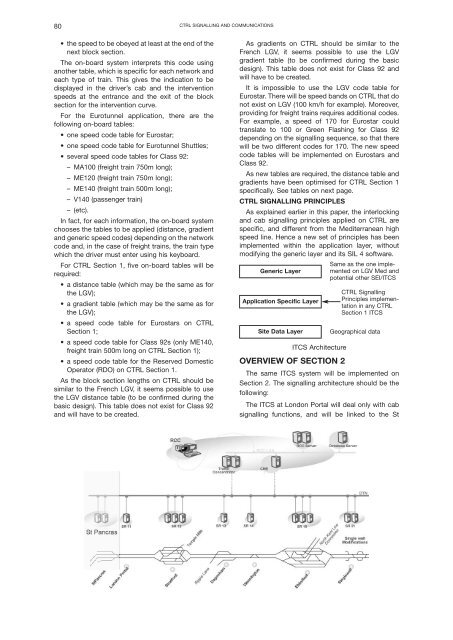Proceedings 2002/2003 - IRSE
Proceedings 2002/2003 - IRSE
Proceedings 2002/2003 - IRSE
Create successful ePaper yourself
Turn your PDF publications into a flip-book with our unique Google optimized e-Paper software.
80<br />
CTRL SIGNALLING AND COMMUNICATIONS<br />
• the speed to be obeyed at least at the end of the<br />
next block section.<br />
The on-board system interprets this code using<br />
another table, which is specific for each network and<br />
each type of train. This gives the indication to be<br />
displayed in the driver’s cab and the intervention<br />
speeds at the entrance and the exit of the block<br />
section for the intervention curve.<br />
For the Eurotunnel application, there are the<br />
following on-board tables:<br />
• one speed code table for Eurostar;<br />
• one speed code table for Eurotunnel Shuttles;<br />
• several speed code tables for Class 92:<br />
– MA100 (freight train 750m long);<br />
– ME120 (freight train 750m long);<br />
– ME140 (freight train 500m long);<br />
– V140 (passenger train)<br />
– (etc).<br />
In fact, for each information, the on-board system<br />
chooses the tables to be applied (distance, gradient<br />
and generic speed codes) depending on the network<br />
code and, in the case of freight trains, the train type<br />
which the driver must enter using his keyboard.<br />
For CTRL Section 1, five on-board tables will be<br />
required:<br />
• a distance table (which may be the same as for<br />
the LGV);<br />
• a gradient table (which may be the same as for<br />
the LGV);<br />
• a speed code table for Eurostars on CTRL<br />
Section 1;<br />
• a speed code table for Class 92s (only ME140,<br />
freight train 500m long on CTRL Section 1);<br />
• a speed code table for the Reserved Domestic<br />
Operator (RDO) on CTRL Section 1.<br />
As the block section lengths on CTRL should be<br />
similar to the French LGV, it seems possible to use<br />
the LGV distance table (to be confirmed during the<br />
basic design). This table does not exist for Class 92<br />
and will have to be created.<br />
As gradients on CTRL should be similar to the<br />
French LGV, it seems possible to use the LGV<br />
gradient table (to be confirmed during the basic<br />
design). This table does not exist for Class 92 and<br />
will have to be created.<br />
It is impossible to use the LGV code table for<br />
Eurostar. There will be speed bands on CTRL that do<br />
not exist on LGV (100 km/h for example). Moreover,<br />
providing for freight trains requires additional codes.<br />
For example, a speed of 170 for Eurostar could<br />
translate to 100 or Green Flashing for Class 92<br />
depending on the signalling sequence, so that there<br />
will be two different codes for 170. The new speed<br />
code tables will be implemented on Eurostars and<br />
Class 92.<br />
As new tables are required, the distance table and<br />
gradients have been optimised for CTRL Section 1<br />
specifically. See tables on next page.<br />
CTRL SIGNALLING PRINCIPLES<br />
As explained earlier in this paper, the interlocking<br />
and cab signalling principles applied on CTRL are<br />
specific, and different from the Mediterranean high<br />
speed line. Hence a new set of principles has been<br />
implemented within the application layer, without<br />
modifying the generic layer and its SIL 4 software.<br />
Same as the one implemented<br />
on LGV Med and<br />
Generic Layer<br />
potential other SEI/ITCS<br />
Application Specific Layer<br />
Site Data Layer<br />
ITCS Architecture<br />
CTRL Signalling<br />
Principles implementation<br />
in any CTRL<br />
Section 1 ITCS<br />
Geographical data<br />
OVERVIEW OF SECTION 2<br />
The same ITCS system will be implemented on<br />
Section 2. The signalling architecture should be the<br />
following:<br />
The ITCS at London Portal will deal only with cab<br />
signalling functions, and will be linked to the St

















